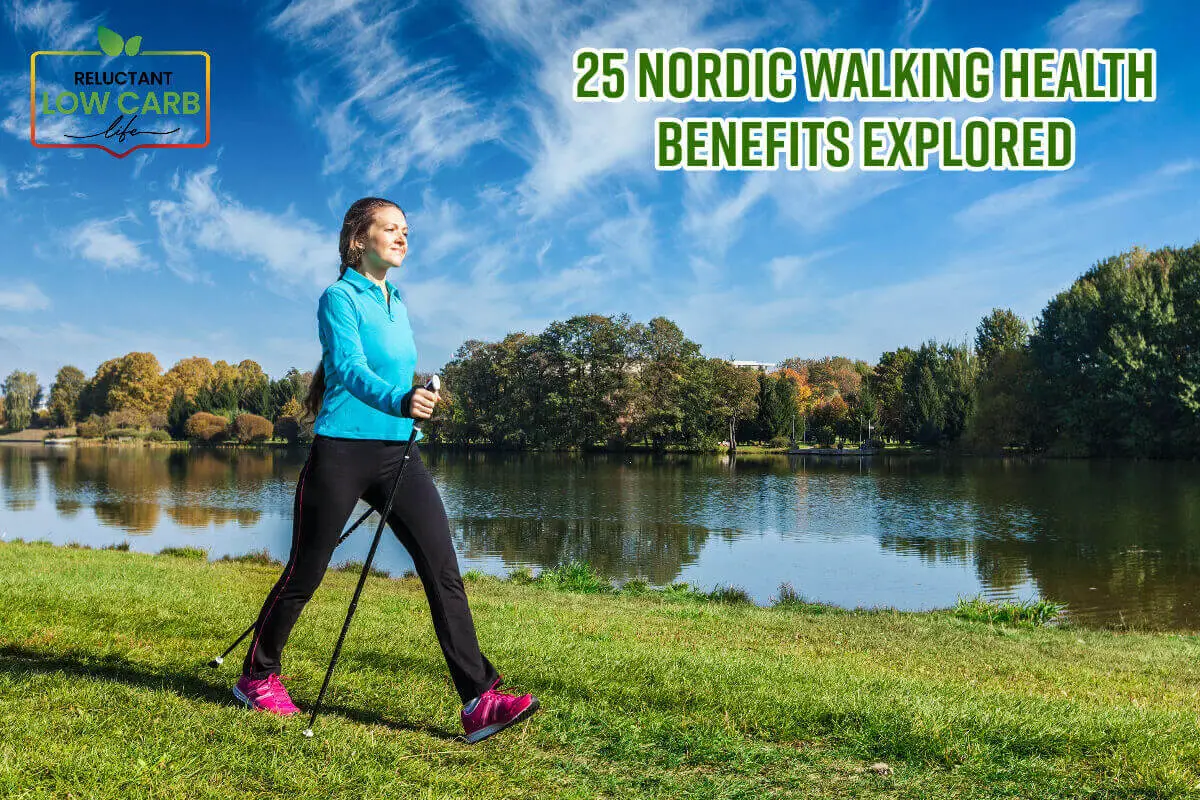I have been Nordic Walking for a while and find it a great exercise. Anyone looking to increase their level of fitness with walking should consider Nordic walking.
After practicing Nordic Walking for some time, I appreciate its incredible benefits. This fitness trend has gained popularity recently and provides more than just a casual outdoor activity. It delivers a comprehensive full-body workout with a plethora of health advantages. Read on as we explore 25 health benefits of Nordic walking.
Table of Contents
- Nordic Walking Health Benefits: Unveiling 25 Reasons To Pick Up The Poles
- 1. Engaging More Muscles
- 2. Enhanced Calorie Burn
- 3. Fat Mass Reduction
- 4. Improved Cholesterol Profile
- 5. Mental Health Benefits
- 6. Chronic Pain Management
- 7. Waist Circumference Reduction
- 8. Increased Muscle Strength
- 9. Enhanced Flexibility
- 10. Extended Walking Distance
- 11. Cardiovascular Fitness Boost
- 12. Quality Of Life Enhancement
- 13. Enhanced Stability
- 14. Posture Improvement
- 15. Stress Reduction
- 16. Better Lung Function
- 17. Increased Bone Density
- 18. Social Connection
- 19. Enhanced Coordination
- 20. Better Post-Injury Rehabilitation
- 21. Weight Management
- 22. Improved Insulin Sensitivity
- 23. Cognitive Benefits
- 24. Lower Blood Pressure
- 25. Sustainability
- Related Question
Nordic Walking Health Benefits: Unveiling 25 Reasons To Pick Up The Poles
When it comes to improving our health and well-being, we often find ourselves searching for activities that are not only enjoyable but also effective. Nordic walking, a fitness trend gaining traction recently, offers a compelling solution. It’s not just a stroll in the park; it’s a full-body workout with numerous health benefits.
Read on as we explore 25 Nordic walking health benefits that make this activity a remarkable choice for fitness enthusiasts of all ages and levels.
1. Engaging More Muscles
When you walk without poles, you primarily activate the muscles below the waist. However, when you add Nordic poles to the equation, you also engage all your upper body muscles. This means you’re utilizing a whopping 80% to 90% of your muscles during Nordic walking, compared to just 50% when walking without poles. This full-body engagement translates into a substantial calorie-burning advantage.
2. Enhanced Calorie Burn
Nordic walking isn’t your average stroll. It’s a dynamic exercise that increases calorie expenditure significantly. Various studies estimate that Nordic walking burns 18% to 67% more calories than regular walking, depending on speed and terrain. So, if you’re looking to shed some extra pounds, grabbing those poles might be the way to go.
3. Fat Mass Reduction
Regular Nordic walking can contribute to a reduction in fat mass, helping you achieve a leaner physique. Engaging multiple muscle groups and increasing your heart rate is an effective fat-burning exercise.
4. Improved Cholesterol Profile
Nordic walking has been associated with improvements in cholesterol levels. It helps lower “bad” LDL cholesterol and triglycerides while boosting “good” HDL cholesterol. This can lead to a decreased risk of heart disease.
5. Mental Health Benefits
Nordic walking isn’t just good for the body but also the mind. Many practitioners report reduced symptoms of depression and anxiety, thanks to the blend of physical activity and outdoor spending in natural settings.

6. Chronic Pain Management
For individuals dealing with chronic pain, Nordic walking can provide relief. The low-impact nature of this activity makes it easier on the joints while offering an effective workout. This can be particularly helpful for those with conditions like arthritis.
7. Waist Circumference Reduction
To trim your waistline, Nordic walking can be a valuable tool. It engages core muscles, helping to strengthen and tone your abdominal region. Over time, this can lead to a reduction in waist circumference.
8. Increased Muscle Strength
Regularly engaging in Nordic walking can improve muscle strength throughout your body. As you use your upper and lower body muscles, they become stronger and more toned.
9. Enhanced Flexibility
Nordic walking involves a full range of motion for your arms, shoulders, and legs. This can contribute to increased flexibility over time, making everyday activities easier and reducing the risk of injury.
10. Extended Walking Distance
One of the great things about Nordic walking is that it can help you increase your walking distance without feeling as tired. By distributing the effort across your entire body, you can go farther and enjoy longer walks.
11. Cardiovascular Fitness Boost
Nordic walking is excellent for cardiovascular health. It elevates your heart rate, increases blood flow, and improves cardiovascular fitness. This can lead to a lower risk of heart disease and improved endurance.
12. Quality Of Life Enhancement
Nordic walking has a positive impact on overall quality of life. Combining physical activity, time spent outdoors, and the social aspect of group walks can enhance your well-being and happiness.
13. Enhanced Stability
Using poles during Nordic walking provides you with additional ground contact points. This added stability reduces the risk of falls or accidents, making it a safer option for people of all ages.
14. Posture Improvement
Nordic walking encourages proper posture. As you engage your upper body and core muscles, you naturally align your spine and shoulders, helping to alleviate poor posture habits.

15. Stress Reduction
Spending time in nature while engaging in a physical activity like Nordic walking has been shown to reduce stress levels. The tranquility of natural environments and the endorphins released during exercise can calm the mind.
16. Better Lung Function
Nordic walking requires deep and controlled breathing, which can lead to improved lung function over time. This is especially beneficial for individuals with respiratory conditions.
17. Increased Bone Density
Weight-bearing exercises like Nordic walking can help increase bone density, reducing the risk of osteoporosis and fractures, particularly in older adults.
18. Social Connection
Nordic walking often occurs in group settings, fostering social connections and a sense of belonging. The camaraderie of walking with others can be motivating and enjoyable.
19. Enhanced Coordination
Coordinating your arm and leg movements while Nordic walking can improve your overall coordination and balance, helping to prevent falls and injuries.
20. Better Post-Injury Rehabilitation
Nordic walking can be an excellent rehabilitation tool after an injury. Its low-impact nature allows individuals to rebuild strength and mobility gradually.
21. Weight Management
By increasing calorie expenditure and promoting muscle growth, Nordic walking can play a significant role in weight management and achieving a healthy body composition.
22. Improved Insulin Sensitivity
Regular physical activity like Nordic walking can enhance insulin sensitivity, reducing the risk of type 2 diabetes.
23. Cognitive Benefits
Physical activity has been linked to improved cognitive function. With its cardiovascular exercise and time spent in nature, Nordic walking may support cognitive health.

24. Lower Blood Pressure
Engaging in Nordic walking can help lower blood pressure levels, reducing the risk of hypertension and its associated health problems.
25. Sustainability
Lastly, Nordic walking is a sustainable and eco-friendly form of exercise. You don’t need special equipment or facilities, making it accessible to almost anyone.
Nordic walking is much more than just a roll with poles. It’s a holistic fitness activity that engages your entire body, improves cardiovascular health, enhances mental well-being, and offers numerous other health benefits.
Whether you’re a fitness enthusiast or simply looking for an enjoyable way to stay active, Nordic walking is a fantastic option. Grab those poles, head outdoors, and experience the transformational benefits of this engaging and accessible activity.
At Reluctant Low Carb Life, we are staunch advocates of the Health Trifecta: Fullness, Fitness, and Freshness. Additionally, we embrace the pillars of health, wellness, and graceful aging. Our mission is to provide honest and precise information to individuals dedicated to adopting a healthy lifestyle while enhancing their fitness and well-being.
We have a free monthly newsletter that is filled with information and helps you remain updated. Subscribe to the Reluctant Low Carb Life newsletter by clicking here.
Listen to our weekly podcast, Reluctant Low Carb Life, on all the major podcast platforms by clicking here.
Follow us on Instagram and Facebook by clicking here.
Related Question
More Effective Weight Loss: Keto Or Calorie Deficit?
We find the keto diet a more effective way to lose weight because your body turns your stored body fat into weight loss. Many people also lose weight on the calorie deficit diet. You must watch what you eat and how much you eat on both diets. Both diets want you to cut out on sugar, and the keto diet wants you to cut out on carbohydrates.
You can read more about More Effective Weight Loss: Keto Or Calorie Deficit? by clicking here.
Losing Weight On Low Carb Without Exercise
You can lose weight on a low-carb or keto diet without exercising. Exercise is only 10% of the weight-loss equation, whereas the low-carb and keto lifestyle will account for at least 90%. For someone to lose weight on a low-carb diet, they need to follow the low-carb diet for ultimate success.
You can read more about Losing Weight On Low Carb Without Exercise by clicking here.
What Are Normal Blood Sugar Levels?
Most healthcare professionals will look at several blood sugar level tests to check if your blood sugar levels are normal. The three significant tests are the A1C blood sugar level, the fasting blood sugar test, and the glucose tolerance test. All these tests have different numbers that help show if you have a normal blood sugar range.
You can read more about What Are Normal Blood Sugar Levels? by clicking here.








